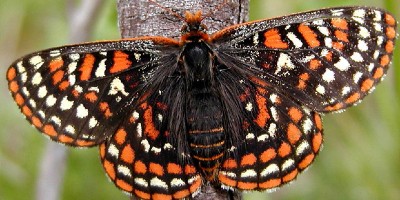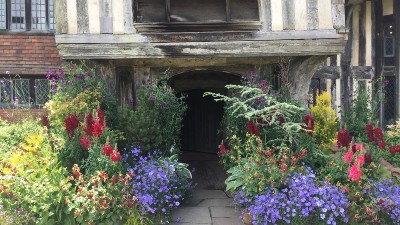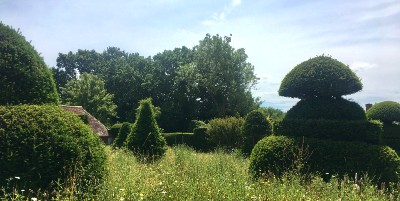 Est. 2008; bringing nature & gardeners together July 11, 2025
|
|
NURSERY NOTES: Join Bailey Hoops on Monday, July 14 for a free Austin Organic Gardeners talk about butterfly gardening. Zilker Botanical Garden. 7 - 8:30 p.m. AOG 🌿

Attention mushroom gardeners and fungi foodies! Visit Howson Library on Tuesday, July 15 at 6 p.m. for a free lesson on how to grow oyster and lion's mane mushrooms. Instructor: Austin Davenport. Austin Public Library 🌿

PRISONERS SAVE RARE BUTTERFLY: women at Mission Creek Correctional Facility near Seattle are hard at work saving the endangered Taylor's checkerspot butterfly, with help from Evergreen State College, and — in a weird twist — the Department of Defense. Last year they released 67,000 larvae. In turn, the women are "reconnecting with their own brilliance," says project coordinator Kelli Bush.
________________________________________________
WATERMELON & MINT SALAD: this recipe comes from the Johnson's Backyard Garden. (It has been closed for a while but the website is still up.) "It is packed with nutrients and a sweet freshness that is perfect for summer," writes Ahmad Watson. Daily Dirt ❦
THE AUSTIN GARDEN relies on readers for support. Whether annual or monthly, all donations are welcome. At present 6% of readers fund this newsletter. Many thanks in advance. PayPal link ❦
 TALES OF GREAT DIXTER
by Darrel Mayers
With a soft wind blowing, and beneath a shining sun, it was a perfect day to visit one of the most talked-about gardens in England: Great Dixter.
Its founder has been called a provocateur and iconoclast, terms unusual in the generally staid world of gardens and gardening. But everyone agrees that Christopher Lloyd knew how to put together a garden.
Orchid-filled meadows, exuberant borders and original topiary all crowd the senses in this East Sussex marvel– and while stately gardens might generate a “how nice” response, most visitors to Dixter simply say “Wow!”
“The great thing is not to be timid in your gardening,” wrote Lloyd. “Whether it’s colours, shapes, juxtapositions or the contents themselves, splash around and enjoy yourself.”
 Topiary arises from a wildflower meadow (photo: dm)
There was a fun late-morning buzz in the air on the sunny Tuesday of our visit. Merry gardeners from near and afar were pointing and exclaiming in multitudes of accents and languages at their surroundings.
Within structures, the plantings all had the freshness of an improvisation… in some cases veering toward slight chaos. The plants sometimes fell over the narrow paths, and your arms would be tickled by leaves as you went about your explorations; holding branches as you passed through for others behind was all part of the fun.
 Young Christo at Great Dixter
Christopher Lloyd, known simply as “Christo,” was born in 1921 into the world of Arts and Crafts, a movement which cherished the individual, artisanal beauty of hand-made objects over those made in a factory.
His father Nathaniel was an architect. He bought Great Dixter in 1910, and it was Christo’s home until his death in 2006. His dad drew up and established “the bones” of the current Dixter gardens with help from Edwin Lutyens, a leading architect of the time.
From the start young Christo was a plant nerd. At age 7 he met the eminent garden designer Gertrude Jekyll, and a year later he had memorized reams of the Latin names of botanical plants.
But while Christo had been born into the Arts and Crafts movement, he soon found himself veering off from its often understated color schemes, to come up with his own livelier version.
He crowded beauty into his garden beds in a rambunctious way, even allowing plants to reseed themselves, and if wildflowers from the surrounding meadows showed up (or other volunteers), they were welcomed too.
No gaps, showing bare earth should be visible from late May on, he wrote. “The effect should be of a closely woven tapestry . . . For all the work that goes into it, I want the border to look exuberant and uncontrived.”
 At one point we found ourselves in a leaning, timbered barn – I’m not sure of its official name - with battered chairs and bales of hay where we could sit and catch our breath. (see photo above)
Above us, from centuries old beams, hung garlands of upside-down teasel and other drying flowers. There was a communal, and beautiful sense of resting, and of drinking in the experience of Dixter – one of the most beautiful and anarchic gardens in the world.
After a hearty outdoor lunch and a visit to the nursery (where I got a clematis for my sister’s garden), we headed off towards the nearby town of Rye, minds still reeling from the magic and fiction of our Great Dixter experience. 11/10 stars. Highly recommended! ❦
__________________________________________________
Great Dixter is 60 miles south of London
Gardens are open March – October.
(This article is reprinted from July 2022)
 |
|
IT'S ABOUT THYME LEGACY PUBLICATIONS.
CONTACT EDITOR DARREL MAYERS |
|
|